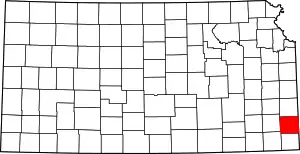Pittsburg, Kansas
Pittsburg is a city in Crawford County, Kansas, United States,[1] located in Southeast Kansas near the Missouri state border. It is the most populous city in Crawford County and southeast Kansas. As of the 2010 census, the city population was 20,233.[7]
Pittsburg, Kansas | |
|---|---|
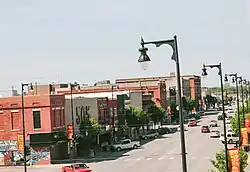 Aerial view of downtown Pittsburg (2017) | |
 Location within Crawford County and Kansas | |
 KDOT map of Crawford County (legend) | |
| Coordinates: 37°24′39″N 94°42′18″W[1] | |
| Country | United States |
| State | Kansas |
| County | Crawford |
| Founded | 1876 |
| Incorporated | 1880 |
| Government | |
| • Type | Mayor–Council |
| • Mayor | Dawn McNay [2] |
| • City Manager | Daron Hall [3] |
| Area | |
| • Total | 13.16 sq mi (34.09 km2) |
| • Land | 13.06 sq mi (33.84 km2) |
| • Water | 0.10 sq mi (0.25 km2) |
| Elevation | 945 ft (288 m) |
| Population | |
| • Total | 20,233 |
| • Estimate (2019)[6] | 20,050 |
| • Density | 1,534.63/sq mi (592.54/km2) |
| Time zone | UTC−6 (CST) |
| • Summer (DST) | UTC−5 (CDT) |
| ZIP code | 66762 |
| Area code | 620 |
| FIPS code | 20-56025 [1] |
| GNIS ID | 469594 [1] |
| Website | pittks.org |
History
On October 23, 1864, a wagon train of refugees had come from Fort Smith, Arkansas, and was escorted by troops from the 6th Kansas Cavalry under the command of Col. William Campbell. These were local men from Cherokee, Crawford, and Bourbon counties. Their enlistment was over, and they were on their way to Fort Leavenworth to be dismissed from service. They ran into the 1st Indian Brigade led by Maj. Andrew Jackson Piercy near the current Pittsburg Waste Water Treatment Plant. They continued to the north when a small group of wagons broke away in an unsuccessful rush to safety. The Confederate troops caught up with them and burned the wagons. The death toll was three Union soldiers and 13 civilian men who had been with the wagon train. It was likely that one of the Confederates had also been killed. A granite marker memorial for the "Cow Creek Skirmish" was placed near the Crawford County Historical Museum on October 30, 2011.[8]
Pittsburg sprang up in the fall of 1876 on a railroad line being built through the neighborhood.[9] It was named after Pittsburgh, Pennsylvania,[10] and maps of the time give the town's name as "New Pittsburgh". George Hobson and Franklin Playter are credited with being the city's founders, establishing a government after its beginnings as a coal mining camp in the 1870s. The city was incorporated in 1879.[11] The “New” was dropped upon incorporation of the City as a third class city on June 21, 1880, with M. M. Snow as its first Mayor. In 1892 it was advanced to a city of the second class, in 1905 Pittsburg attained the rank of first class.
.jpg.webp)
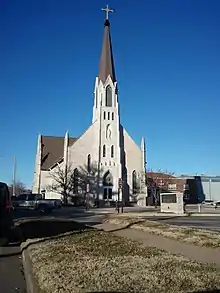
The first dwelling was built by J. T. Roach in July 1876.[12] The first post office in Pittsburg was established in August, 1876. The post office's name was shortened from "New Pittsburgh" to "Pittsburgh" in 1881 and to "Pittsburg" in 1894.[13] The latter renaming came after the United States Board on Geographic Names, in the interest of standardization, recommended that the 'h' be dropped from place names ending in "burgh".[14]
Pittsburg is the home to Pittsburg State University, founded in 1903 as a normal training institution. Through the years the College became more diversified in its aims and goals, so that it became a multi-purpose institution. It has always had a strong manual and industrial arts program and has trained many of the area's public and private school teachers.
In 1879, two miners from Joplin began the first commercial attempts at mining in close proximity of Broadway Street. A relic of the city's coal mining days was the Pittsburg & Midway Coal Company, founded in 1885, and one of the oldest continuously running coal companies in the United States (even though its headquarters moved several years ago to Denver, Colorado after the Kansas mines closed). In September 2007, Chevron which owned the company, merged it with its Molycorp Inc. coal mining division to form Chevron Mining, thus ending the Pittsburg corporate name.[15] Midway referred to a coal camp in eastern Crawford County, Kansas that was "midway" between Baxter Springs, Kansas and Fort Scott, Kansas.[16] Kenneth A. Spencer, whose father was among the founders of the company was to play an important role in Kansas and Missouri philanthropy.
Pittsburg was also the most heavily unionized city in Kansas at the beginning of the 20th century.[17] In addition to some coal mining, the economic base of the City now rests on industry.
The city has a rich cultural heritage from many Southern and Eastern European mine workers who settled in and around Pittsburg and Southeastern Kansas. It is situated in a once productive coal field. It now relies heavily on education and government-related employment.
Geography
Pittsburg is located at 37°24′37″N 94°41′59″W.[18] According to the United States Census Bureau, the city has a total area of 12.90 square miles (33.41 km2), of which, 12.80 square miles (33.15 km2) is land and 0.10 square miles (0.26 km2) is water.[19] Pittsburg sits in the Ozark Highlands region, a mix of prairie and forests.
It lies 90 miles (140 km) west of Springfield, Missouri, 124 miles (200 km) south of Kansas City, Missouri, and 137 miles (220 km) northeast of Tulsa, Oklahoma.
Climate
Pittsburg has a humid subtropical climate (Köppen Cfa) bordering on a hot-summer humid continental climate (Dfa). Summers are very hot, humid and uncomfortable, with as many as 73 mornings per year staying above 68 °F or 20 °C and eight mornings remaining above 77 °F or 25 °C – indeed in July 2012 the temperature did not fall below 69 °F or 20.6 °C.[20] The hottest morning, however, was on August 10, 2006 when the temperature did not fall below 83 °F (28.3 °C), and the hottest temperature has been 115 °F (46.1 °C) on July 13 and 14, 1954. Heavy thunderstorm rains often punctuate the heat with heavy rainfall: 7.93 inches or 201.4 millimetres fell on July 30, 2013. However, long periods of dangerously hot weather without much rain are not uncommon: only trace precipitation fell between July 28 and September 10, 2000, and only 0.22 inches (5.6 mm) between July 7 and August 20, 1984.
During the fall season, temperatures cool off fairly rapidly: the last 90 °F or 32.2 °C temperature can be expected on September 22, and by the end of October temperatures have usually fallen to a comfortable level. Heavy rainfall from frontal systems or remnant tropical storms are common during this period: the wettest day with 8.77 inches (222.8 mm) was on September 25, 1993, a year which saw 47.85 inches (1,215.4 mm) between April and September as against only 10.54 inches (267.7 mm) during the same period in 1980. September 1993 was also the wettest month on record with 19.37 inches or 492.0 millimetres, while the wettest calendar year overall has been 1985 with 66.52 inches (1,689.6 mm) and the driest 1963 with only 21.50 inches (546.1 mm).
As with all of Kansas, winter weather is extremely variable, although extreme maxima are not as hot as in the southwest of the state as Pittsburg is far from the influence of hot chinook winds. Arctic outbreaks bring temperatures to or below 0 °F or −17.8 °C on average once per winter, while maxima over 70 °F or 21.1 °C can be expected four times between December and February. Winter weather is less dry than in most of Kansas since moist Gulf air often penetrates without reaching most of the state: December 2015 saw 7.91 inches (200.9 mm) of rain, and the very cold January 1979 saw sixteen days with at least 0.01 inches or 0.25 millimetres of measurable precipitation. Because the moister air masses are warm, heavy snowfall is uncommon in Pittsburg: the mean is 11.9 inches or 0.30 metres and only twelve months have seen more than 10 inches or 0.25 metres, with the most in a month being 24.5 inches (0.62 m) in January 1979. The most snow in a day has been 13 inches (0.33 m) on December 13, 2000, and the most snow on the ground 14 inches (0.36 m) on February 4 and 5, 2011 and March 17, 1970.
Spring weather is changeable and often suspect to severe storms: Pittsburg lies in the heart of “Tornado Alley”. The changeable weather from hot to cold can be accompanied by frequent heavy precipitation: Pittsburg can expect 20.24 inches or 514.1 millimetres of precipitation between March and June, approximately what Dodge City or Liberal further west receive in a whole year. Temperatures warm up erratically during the spring: the first temperature of 80 °F (26.7 °C) can be expected on March 27, but the first of 90 °F (32.2 °C) does not normally occur until May 28.
| Climate data for Pittsburg, Kansas | |||||||||||||
|---|---|---|---|---|---|---|---|---|---|---|---|---|---|
| Month | Jan | Feb | Mar | Apr | May | Jun | Jul | Aug | Sep | Oct | Nov | Dec | Year |
| Record high °F (°C) | 74 (23) |
83 (28) |
89 (32) |
97 (36) |
96 (36) |
105 (41) |
115 (46) |
109 (43) |
106 (41) |
96 (36) |
84 (29) |
76 (24) |
115 (46) |
| Mean maximum °F (°C) | 68 (20) |
71 (22) |
80 (27) |
85 (29) |
90 (32) |
96 (36) |
100 (38) |
102 (39) |
96 (36) |
88 (31) |
77 (25) |
67 (19) |
98 (37) |
| Average high °F (°C) | 42 (6) |
48 (9) |
58 (14) |
68 (20) |
77 (25) |
85 (29) |
90 (32) |
90 (32) |
81 (27) |
70 (21) |
57 (14) |
44 (7) |
67.5 (19.7) |
| Average low °F (°C) | 23 (−5) |
27 (−3) |
35 (2) |
45 (7) |
56 (13) |
65 (18) |
69 (21) |
68 (20) |
58 (14) |
47 (8) |
36 (2) |
25 (−4) |
46.2 (7.9) |
| Mean minimum °F (°C) | 6 (−14) |
11 (−12) |
20 (−7) |
31 (−1) |
42 (6) |
54 (12) |
61 (16) |
58 (14) |
46 (8) |
33 (1) |
20 (−7) |
9 (−13) |
3 (−16) |
| Record low °F (°C) | −12 (−24) |
−16 (−27) |
−6 (−21) |
20 (−7) |
32 (0) |
47 (8) |
51 (11) |
48 (9) |
32 (0) |
19 (−7) |
5 (−15) |
−18 (−28) |
−18 (−28) |
| Average precipitation inches (mm) | 1.67 (42) |
2.28 (58) |
3.65 (93) |
4.33 (110) |
6.44 (164) |
5.72 (145) |
3.96 (101) |
3.22 (82) |
4.79 (122) |
4.16 (106) |
3.14 (80) |
2.45 (62) |
45.81 (1,165) |
| Average snowfall inches (cm) | 3.8 (9.7) |
2.5 (6.4) |
1.6 (4.1) |
trace | 0.0 (0.0) |
0.0 (0.0) |
0.0 (0.0) |
0.0 (0.0) |
0.0 (0.0) |
trace | 0.8 (2.0) |
2.3 (5.8) |
11.9 (30) |
| Average precipitation days (≥ 0.01 inch) | 7 | 7 | 9 | 9 | 11 | 10 | 8 | 7 | 8 | 7 | 7 | 7 | 94 |
| Source 1: weather.com[21] | |||||||||||||
| Source 2: National Weather Service, Springfield, Missouri[20] | |||||||||||||
Demographics
| Historical population | |||
|---|---|---|---|
| Census | Pop. | %± | |
| 1880 | 624 | — | |
| 1890 | 6,697 | 973.2% | |
| 1900 | 10,112 | 51.0% | |
| 1910 | 14,755 | 45.9% | |
| 1920 | 18,052 | 22.3% | |
| 1930 | 18,145 | 0.5% | |
| 1940 | 17,571 | −3.2% | |
| 1950 | 19,341 | 10.1% | |
| 1960 | 18,678 | −3.4% | |
| 1970 | 20,171 | 8.0% | |
| 1980 | 18,770 | −6.9% | |
| 1990 | 17,775 | −5.3% | |
| 2000 | 19,243 | 8.3% | |
| 2010 | 20,233 | 5.1% | |
| 2019 (est.) | 20,050 | [6] | −0.9% |
| U.S. Decennial Census | |||
2010 census
As of the census[5] of 2010, there were 20,233 people, 8,142 households, and 4,087 families residing in the city. The population density was 1,580.7 inhabitants per square mile (610.3/km2). There were 9,210 housing units at an average density of 719.5 per square mile (277.8/km2). The racial makeup of the city was 87.1% White, 3.3% African American, 0.9% Native American, 2.0% Asian, 0.3% Pacific Islander, 3.0% from other races, and 3.4% from two or more races. Hispanic or Latino of any race were 6.7% of the population.
There were 8,142 households, of which 27.1% had children under the age of 18 living with them, 33.3% were married couples living together, 12.2% had a female householder with no husband present, 4.8% had a male householder with no wife present, and 49.8% were non-families. 32.8% of all households were made up of individuals, and 10.8% had someone living alone who was 65 years of age or older. The average household size was 2.31 and the average family size was 2.97.
The median age in the city was 26.2 years. 20.7% of residents were under the age of 18; 27% were between the ages of 18 and 24; 23.3% were from 25 to 44; 17.3% were from 45 to 64; and 11.7% were 65 years of age or older. The gender makeup of the city was 49.9% male and 50.1% female.
2000 census
As of the census[5] of 2000, there were 19,243 people, 7,980 households, and 4,213 families residing in the city. The population density was 1,546.2 people per square mile (596.8/km2). There were 8,855 housing units at an average density of 711.5 per square mile (274.6/km2). The people are 89.73% White, 3.11% Black/African American, 1.08% Native American, 1.94% Asian, 0.17% Pacific Islander, 1.90% from other races, and 2.08% from two or more races. Hispanic or Latino of any race were 3.75% of the population.
There were 7,980 households, out of which 25.1% had children under the age of 18 living with them, 38.0% were married couples living together, 11.2% had a female householder with no husband present, and 47.2% were non-families. 34.5% of all households were made up of individuals, and 12.7% had someone living alone who was 65 years of age or older. The average household size was 2.23 and the average family size was 2.91.
In the city, the population was spread out, with 20.8% under the age of 18, 24.1% from 18 to 24, 24.1% from 25 to 44, 16.8% from 45 to 64, and 14.1% who were 65 years of age or older. The median age was 28 years. For every 100 females, there were 94.1 males. For every 100 females age 18 and over, there were 92.0 males.
The median income for a household in the city was $24,221, and the median income for a family was $36,674. Males had a median income of $26,312 versus $20,132 for females. The per capita income for the city was $15,318. About 13.6% of families and 22.5% of the population were below the poverty line, including 24.2% of those under age 18 and 10.3% of those age 65 or over.
Culture

Events
Little Balkans Days is a celebration unique to Pittsburg. This three-day festival celebrating the community's European ethnic heritage features games, entertainment, a parade, competitions, and arts and crafts. It is held in conjunction with the Labor Day holiday.[22]
Government
The Pittsburg government consists of a mayor and four commissioners. The commission meets the 2nd and 4th Tuesday of each month at 5:30 pm.[23][3]
Education
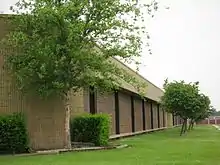
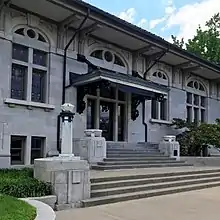
Primary and secondary education
The city is served by Pittsburg USD 250 public school district, which operates the following schools:
- Pittsburg High School
- Pittsburg Community Middle School
- George Nettels Elementary School
- Lakeside Elementary
- Meadowlark Elementary School
- Westside Elementary
Private schools:
- St. Mary's-Colgan High School, Parochial Catholic School
- Countryside Christian School, Private Christian School (K-8)
- Covenant Harvest, Christian School
College
- Pittsburg State University
- Fort Scott Community College, School of cosmetology
- Labette Community College, Cherokee Center
Library
- Pittsburg Public Library
- Leonard H. Axe Library at Pittsburg State University
Media
The Pittsburg Morning Sun is the main newspaper in the city, published five days a week.[24][25] In addition, Pittsburg State University publishes a weekly student newspaper, the Collegio.[26]
Pittsburg is a center of broadcast media for southeastern Kansas. Two AM and five FM radio stations are licensed to and/or broadcast from the city, and it is the second principal city of the Joplin-Pittsburg television market.[27][28] The market's CBS and Fox network affiliates both broadcast from the city along with an independent station.[29][30][31]
In popular culture and the arts
In late 2012, NBC news anchor Brian Williams, who started his career in Pittsburg, Kansas as a journalist at KOAM-TV, covered the local story of a fried chicken war between Chicken Annie's and Chicken Mary's on the Travel Channel.[32] The competition began in 1941 when Chicken Mary's opened across the street from Chicken Annie’s (founded 1934). The friendly rivalry continues, with members of each restaurant's founding family who married running a third restaurant.[33]
Infrastructure
Public transportation
- Bus System, Pittsburg Area Community Transportation (P.A.C.T)
- Taxi services
Airport
- Atkinson Municipal Airport, Aircraft based on the field 41
Medical
- Via Christi Hospital (formerly Mt. Carmel Regional Medical Center) serves the area with services such as Regional Cancer and Heart Centers.
Notable people
Notable individuals who were born in and/or have lived in Pittsburg include actor Roy Glenn,[34] chemical entrepreneur Kenneth A. Spencer,[35] and broadcast journalism pioneer Paul White.[36]
References
- Geographic Names Information System (GNIS) details for Pittsburg, Kansas; United States Geological Survey (USGS); October 13, 1978.
- Pittsburg - City Commissioners
- Pittsburg - Government
- "2019 U.S. Gazetteer Files". United States Census Bureau. Retrieved July 24, 2020.
- "U.S. Census website". United States Census Bureau.
- "Population and Housing Unit Estimates". United States Census Bureau. May 24, 2020. Retrieved May 27, 2020.
- "2010 City Population and Housing Occupancy Status". U.S. Census Bureau. Retrieved March 6, 2011.
- Engraved memorial marker dedicated to lives lost in Cow Creek Skirmish; The Morning Sun; November 1, 2011. Archived April 4, 2012, at the Wayback Machine
- A Twentieth Century History and Biographical Record of Crawford County, Kansas. The Lewis Publishing Company. 1905. pp. 34.
- Kansas State Historical Society (1916). Biennial Report of the Board of Directors of the Kansas State Historical Society. Kansas State Printing Plant. pp. 171.
- Blackmar, Frank Wilson (1912). Kansas: A Cyclopedia of State History, Volume 2. Standard Publishing Company. pp. 480.
- "History of Pittsburg, Official Homepage of the city". Archived from the original on September 10, 2015. Retrieved January 24, 2015.
- "Kansas Post Offices, 1828-1961, page 2". Kansas Historical Society. Archived from the original on October 9, 2013. Retrieved June 6, 2014.
- First Report of the United States Board on Geographic Names. 1890–1891. Washington, DC: U.S. Government Printing Office. 1892. p. 8. Retrieved August 15, 2018.
- Chevron executive bullish on growth of coal industry – Denver Business Journal – November 16, 2007
- Former Mining Communities of the Cherokee-Crawford Coal Field of Southeastern Kansas – Kansas Historical Quarterly – Summer 1972
- Randy Roberts, Janette Mauk: Pittsburgh, Introduction, p. 9., 2009, ISBN 9780738561165
- "US Gazetteer files: 2010, 2000, and 1990". United States Census Bureau. February 12, 2011. Retrieved April 23, 2011.
- "US Gazetteer files 2010". United States Census Bureau. Archived from the original on January 12, 2012. Retrieved July 6, 2012.
- National Weather Service; NOW Data, Springfield, Missouri
- "Monthly Averages for Pittsburg, Kansas". Weather.com. The Weather Channel. Retrieved August 15, 2013.
- "Little Balkans Days History". littlebalkansfestival.com. Retrieved December 15, 2018.
- Pittsburg - Directory of Public Officials
- (24 March 2017). Morning Sun to move to five day schedule, Morning Sun
- "Record Details - Pittsburg Morning Sun". Kansas Press Association. Retrieved August 15, 2013.
- "PSU Collegio". Mondo Times. Retrieved December 17, 2011.
- "Radio Stations in Pittsburg, Kansas". Radio-Locator. Retrieved December 17, 2011.
- "Joplin-Pittsburg TV Market". EchoStar Knowledge Base. Retrieved December 17, 2011.
- "Stations for Joplin, Missouri". RabbitEars.Info. Retrieved December 17, 2011.
- "TVQ TV Database Query". Federal Communications Commission. Archived from the original on May 8, 2009. Retrieved December 17, 2011.
- "AMGTV Affiliates" (PDF). AMGTV. Retrieved December 17, 2011.
- Brian Williams covers Fried Chicken feud
- Meyer, Diana Lambdin (April 30, 2020). "America's 'fried chicken war'". BBC News.
- "Roy Glenn". IMDb. Retrieved April 4, 2016.
- "Kenneth & Helen Spencer of Kansas". Pittsburg State University. Retrieved April 4, 2016.
- Moore, Barbara (May 13, 2013). Sterling, Christopher H. (ed.). Biographical Encyclopedia of American Radio. Abingdon-on-Thames: Routledge. p. 406.
Further reading
External links
| Wikimedia Commons has media related to Pittsburg, Kansas. |
| Wikisource has the text of a 1911 Encyclopædia Britannica article about Pittsburg, Kansas. |
- City
- Historical
- . Collier's New Encyclopedia. 1921.
- . . 1914.
- . New International Encyclopedia. 1905.
- Maps
- Pittsburg City Map, KDOT
.jpg.webp)
